CHAPTER 46
Playgrounds for All Children
A good way to start a village or neighborhood rehabilitation program is to involve the local people in building a low-cost 'rehabilitation playground'. It is important that the playground be built for use by all children-both disabled and non-disabled.
With a little help from adults, the local children can build most of the playground themselves. To prevent the playground from being destroyed or vandalized, you may wish to invite-some of the roughest local children and 'gang leaders' to help lead the project. Or you can appoint them as 'maintenance chiefs'.

Building a playground 'for all children' is a good way to get enthusiastic community participation. It can be built quicklyas a group project at low cost using local resources and gives quick, easily seen, fun results.
| The playground brings non-disabled and disabled children together through play. |
To build the playground, it is best to use local, low-cost materials,and simple construction. One of the playground's main purposes is to give disabled children and their parents a chance to try different playthings and exercise equipment. Whatever works for their child, a family can easily build at home, at no or low cost. For this reason, a playground made of tree limbs and poles, old tires, and other 'waste' materials is more appropriate than a fancy metal playground built by skilled craftsmen at high cost. (Also, metal gets very hot in hot, sunny climates.)
These pages will give you some ideas for simple playground equipment. Although most of the photos come from PROJIMO in Mexico, many of the ideas shown are based on a playground in Thailand (see Page 425) and on designs by Don Caston (see Page 642).
A 'Playground for all' built by children -PROJIMO, Mexico
When disabled village health workers in the small village of Ajoya decided to start a rehabilitation program for disabled children, one of the first activities was to involve the local children in building a playground.
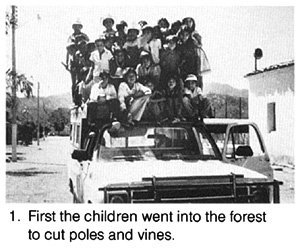
|

|
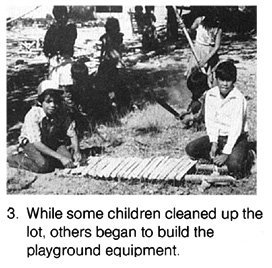
|

|

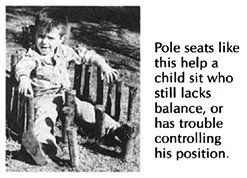
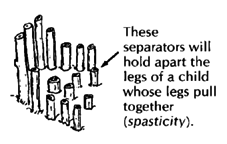
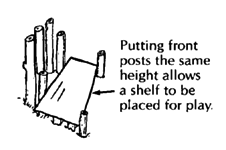

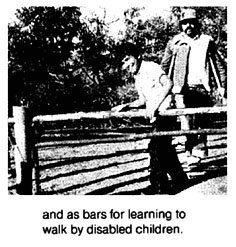
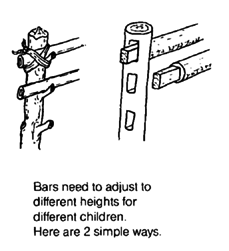

For most children, the bar should be about hip height, so that the elbows are a littie bent (the same height as the handles of crutches).
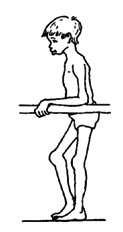
A child with very weak upper arms may find it easier to rest his forearms on the bar. The bar will need to be elbow high.

A child who tends to slump forward may be helped to stand straighter if the bar is high, so that he has to stand straighter to rest his arms on it.
SEPARATION OF BARS
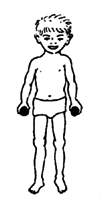
Bars should be close enough to leave only a little room on either side of the child's body. Too close, they get in the way. Too far apart makes weight bearing more difficult. |
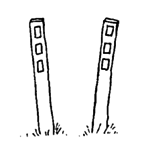
Smaller children require closer bars. Therefore, put uprights so they are wider higher up. |
Simple, homemade bars, adjusted to the individual child's needs, often provide more benefit than expensive walkers or other equipment.
TEETER BRIDGE
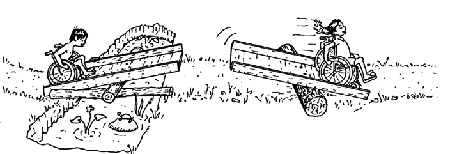
This can be part of an obstacle course for
wheelchairs, including hills, drops, curbs, rocky ground,
sand pits, and zig-zags between posts.
A simple seesaw or teeter-totter like this is fun and helps disabled children gain balance. The one in the photo was made by putting a pole in the crotch of a mango tree.
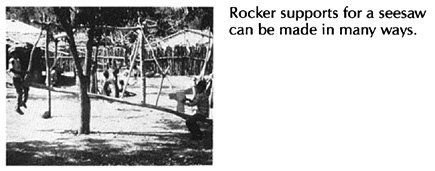
|

|

|
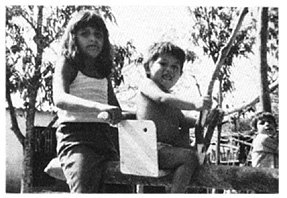
One end of this seesaw has an enclosed seat for a disabled child. Space is left behind the seat for an able-bodied child to sit and protect the disabled child. |
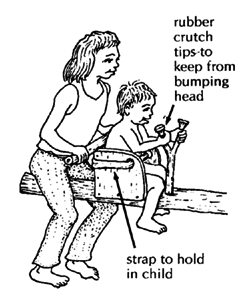
|
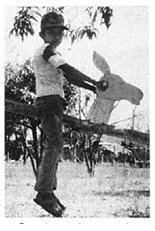
On the other end a wooden donkey head adds fun. |
Here are some other ideas for seesaws.
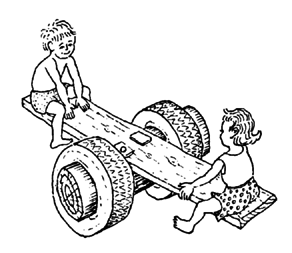
|
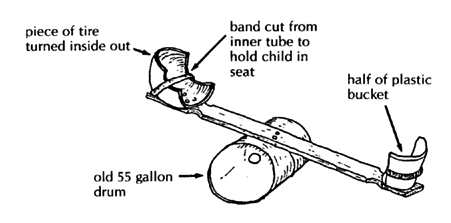
|
PRECAUTIONS
- To avoid accidents, be sure the pole for the seesaw is strong enough. Test it every few weeks by having 2 adults put their full weight on the ends of the pole.
- To avoid coming down too hard, put old tires under the ends of the seesaw (see Page 425.)
- Make sure the seesaw will not roll lengthwise or sideways (see above).
For another seesaw idea, see Page 425.
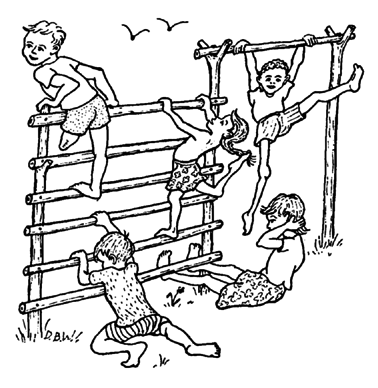
CLIMBING FRAME AND HIGH BAR
Children can make a simple climbing frame out of poles, by nailing them or tying them together with string.
The climbing frame can be used for all kinds of play, for helping disabled children pull up to sitting or standing, and for therapy exercise.
High bars (horizontal bars) at different levels for different children can be used for exercise and gymnastics.
TIRE GYM
Climbing gyms can be made out of many materials, including old tires.


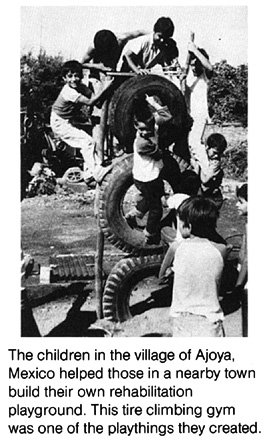
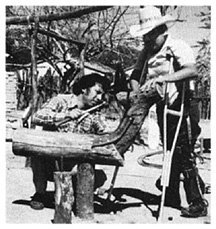
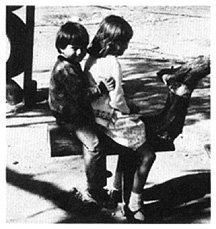
Building and riding a rocking horse made of logs.
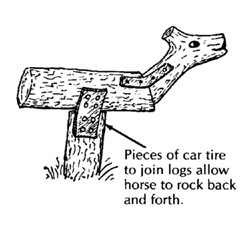
SWINGS
A wide variety of swings can be built out of different local materials. Swinging is fun; it can help develop balance, head control, coordination, and strength. Swings with special features can be built for the needs of particular children.
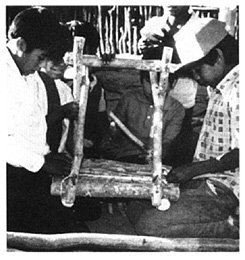
Here children in PROJIMO make an elclosed swing. |

This child with cerebral palsy had never had a chance to swing before. At first he was afraid... |
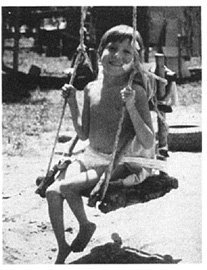
but after a while, he loved it. |
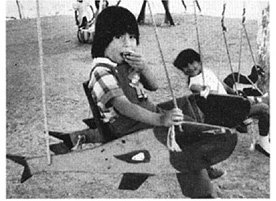
Swings in the form of animals or fish add to the fun |

Regular swings are placed next to special and enclosed swings. so that non-disabled and disabled children learn to play side by side. |
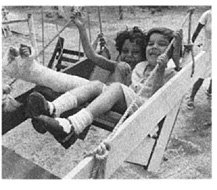
Extra wide swings allow 2 children to swing together - one assisting the other. |


SWINGS AND PLAYTHINGS USING OLD TIRES AND TUBES
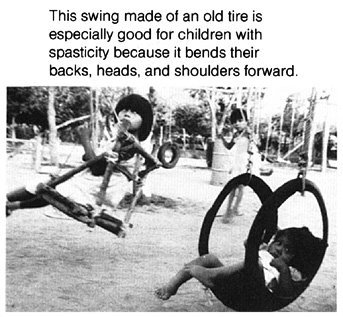
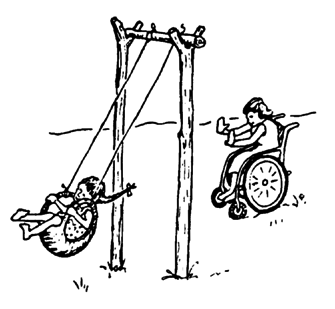
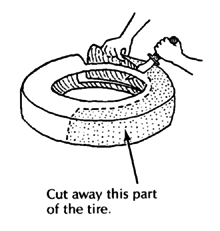
|
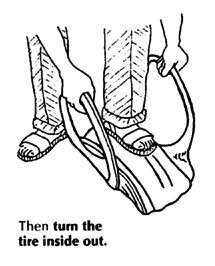
|
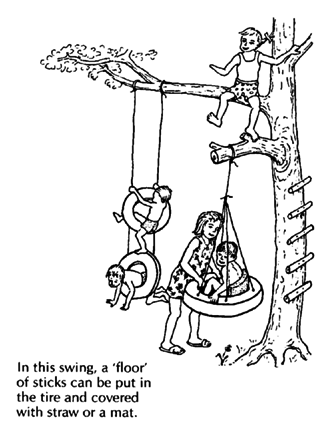
|
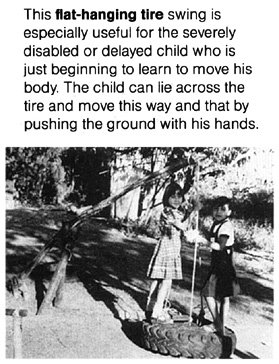
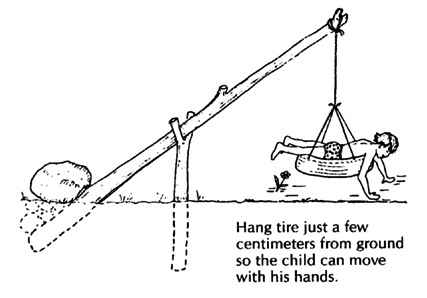
It swings! It spins! It bounces!
Fun for the able-bodied!
Fun for the disabled!
Several children can play on it at once!
WHIRLIGIG CIRCULAR SWING
![]()
Hole in beam is soaked in old motor oil to make it turn around easier.
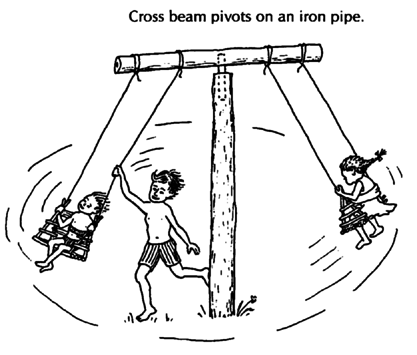
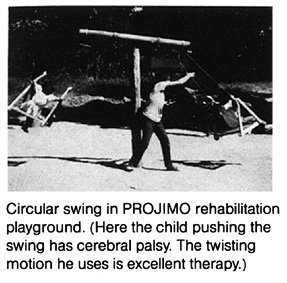
| CAUTION: Be sure both the pole and beam are of strong hard wood. Test them occasionally with adults' weight. |
BOUNCING TUBE
(from Low Cost Physiotherapy and Low Cost Walking Aids, see Page 642.)

BOUNCING TIRE HOBBY HORSE (OR COW)
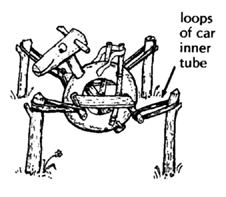
Be sure to notch poles and attach tubes so they do not slip. |
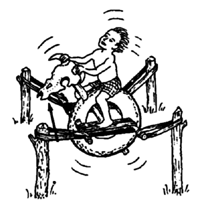
A cow's skull makes a good head for many playground toys. The child holds onto the horns. (Cut off the points.) |
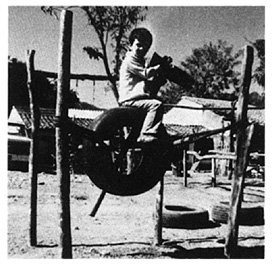
|
Note: It is much easier to put holes through tires that do not have steel wire in them.
MAYPOLE
Disabled children who can sit and hang on can play with non-disabled children on the maypole. But to start turning round the circle, they may need another child to help push them.
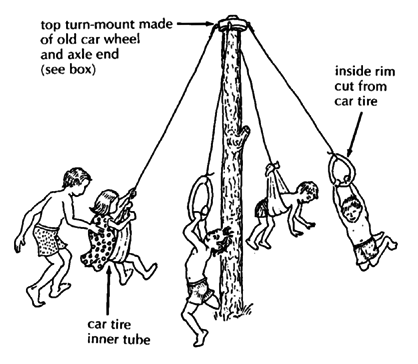
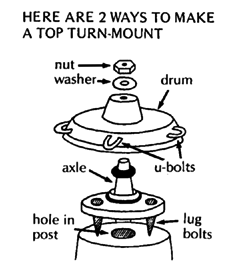
|

|
HANGING SEESAW SWING
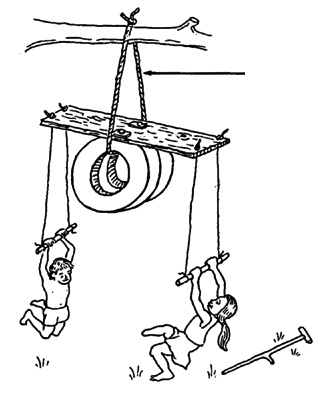
The weight of the tires adds stability for smoother swinging.
| WARNING: Be sure to use extra strong rope or cable in any equipment where children could be seriously hurt if. the rope breaks. Adults should test rope strength regularly. |
OBSTACLE COURSE
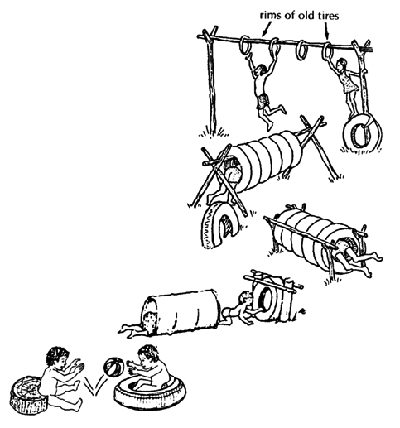
Old tires and drums can be used for crawling games and obstacle courses.
BALANCE BOARDS
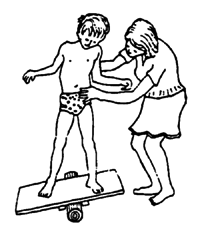
|
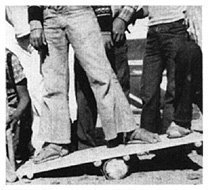
|
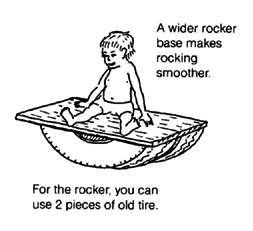
|
For more balance boards and balance beams, see Page 576.
ROLLS
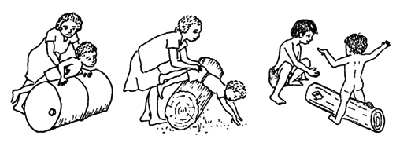
|
||
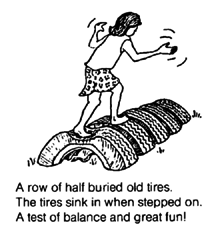
|
Old barrels, oil drums, paint cans, and logs make good playground equipment-for therapy and fun.
CRAWL-THROUGH DRUMS

HANGING CRAWL-THROUGH DRUMS
| CAUTION: Hold drums apart with sticks to
prevent smashed hands and feet.
|

RING-TOSS
 |
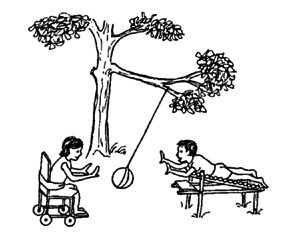
|
For children who have trouble going after dropped balls or rings, tying a string to the toy allows the children to pull it to them.
Examples from the 'bamboo playground' in the Khao-i-dang refugee camp, Thailand

SEESAW with enclosed seats
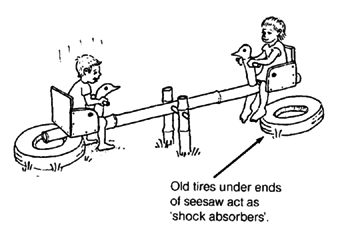
PARALLEL BARS for a child whose knees pull together
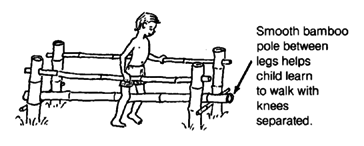
HIGHER PARALLEL BARS for taller child.
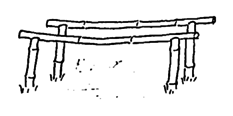
CIRCULAR WALKER
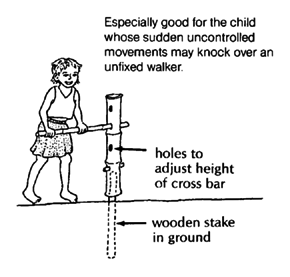
MERRY-GO-ROUND
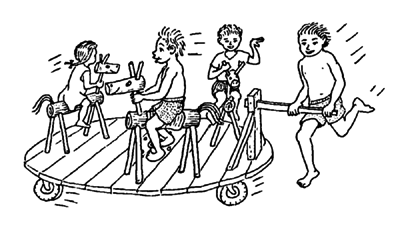
One way to mount the platform of a merry-go-round.
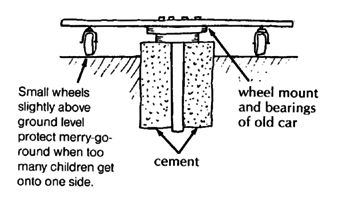
PRECAUTIONS AND SUGGESTIONS FOR A SUCCESSFUL ALLCHILDREN'S PLAYGROUND
- Involve as much of the community as possible in building and maintaining the playground.
- Keep the playground simple and build it from local low-cost materials. Only this way can it serve as a model for families of disabled children to build the most useful equipment for their child in their own homes. Resist offers from the local mayor or politicians to build an impressive metal frame playground. This will eliminate community participation and makes the equipment too costly for poor families to build at home.
- For poles that are put into the ground, use a kind of wood
that does not rot quickly. Or paint the posts with old motor oil,
creosote, tar, copper sulfate or some other insect and fungus
resistant substance.
If poles are used that will rot quickly, to avoid accidents, check strength of poles frequently and replace them at regular intervals -especially during the hot rainy season.
- Swings can be hung from ropes or chains. Rope or vines are cheaper but may rot or wear through fairly quickly. Plastic or nylon rope will not rot in the rains, but will gradually grow brittle and weak with the sun. As with posts, to avoid accidents, check the strength of ropes frequently by having several heavy persons hang on them at one time. Replace ropes at regular intervals,before they get weak.
- Regular maintenance of the playground is essential, and this will require planning and organization. Perhaps once a month the village children can take an expedition to cut new poles to replace rotting ones, to repair old equipment, and to build new. Adult coordination of such activity is usually necessary.
- To boost enthusiasm, keep lists in a public place of all the children and adults who help with the playground-and put a star for each time they help.




